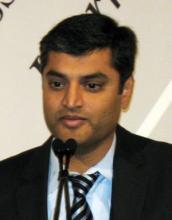The heart team has drawn fans since the franchise first took the field about 3 years ago, but how has it fared in the standings?
It may be hard to believe, given how quickly the heart team concept wormed its way into the cardiac mindset and lexicon, that the term seems to have been first coined in August 2010, when the most recent edition of the myocardial revascularization guidelines of the European Society of Cardiology was unveiled at the society’s annual meeting and then published 2 months later.
The ESC revascularization guidelines (Euro. Heart J. 2010;31:2501-55), as well as authors who have written about heart teams since then, credited the name to investigators from the Synergy Between PCI With Taxus and Cardiac Surgery (SYNTAX) trial, the group that formalized the idea of an interventional cardiologist and cardiac surgeon closely collaborating in assessing and managing patients with complex coronary artery disease who need revascularization.
The heart team approach received further support a year later, when the 2011 revascularization guidelines for percutaneous coronary intervention (Circulation 2011;124:2574-2609) and for coronary artery bypass surgery (Circulation 2011;124: 2610-42) of the American College of Cardiology, the American Heart Association, surgical societies such as the Society for Thoracic Surgery (STS), and several other groups repeated what the ESC had said and tapped heart teams – a joint consult between an interventional cardiologist and a heart surgeon – as the basic decision maker for the management of unprotected left main or complex coronary artery disease. Both the 2011 PCI and coronary artery bypass graft (CABG) guidelines said that "a heart team approach to revascularization is recommended" for these advanced-disease patients, a class I recommendation.
Further buttressing the role of heart teams, as well as muddying the waters on exactly which physicians and surgeons belong on a heart team, has been their growing role in managing other cardiac disorders, most notably for transcatheter aortic valve replacement (TAVR). Last May, the Centers for Medicare and Medicaid Services solidified the link when it ruled that it would pay for TAVR in Medicare beneficiaries only if a heart team was involved from the start. As a result, heart teams are now more tightly and consistently entwined with TAVR than they are with revascularization, where the use of a heart team tracks closely with the increased complexity of a patient’s coronary disease.
Broadening use of heart teams also makes them a little harder to define, as the interventionalist and surgeon collaboration on TAVR involves different jobs and different players than does coronary revascularization. The role heart teams play in early 2013 for U.S. revascularization of coronary disease remains a bit fuzzy. Every interventional cardiologist and cardiac surgeon have their sense of how they use heart teams and how other physicians and surgeons at their hospitals use them for revascularization cases, but a global accounting of the extent to which the heart team concept has penetrated American practice is totally lacking, and will likely stay that way.
Revascularization heart teams remain poorly defined
"The notion of encouraging multidisciplinary care in cardiovascular medicine, exemplified by the heart team concept has gained increasing traction" for revascularization, TAVR, and other complex endovascular interventions, Dr. Brahmajee K. Nallamothu and Dr. David J. Cohen wrote in a perspective article last year (Circulation Cardiovasc. Qual. Outcomes 2012;5:410-3). Examples of that traction include adding heart teams to guidelines, and sessions that focus on heart teams at meetings, Dr. Nallamothu said in an interview.
But thinking of heart teams as formal entities for coronary disease, as formal as for TAVR, is tricky. "The heart team concept always sounds like a great idea, but the real gap has been in showing people in real-world practice how they can apply the idea of a heart team to front-line decision making about patients undergoing revascularization," said Dr. Nallamothu, an interventional cardiologist at the University of Michigan in Ann Arbor. "We have not shown hospitals and physicians how to do this in a practical way. We need more discussions by multidisciplinary teams about complex patients." Heart teams "have filtered into our guidelines without showing doctors how you do it practically, and even if you can, how do you pay people for doing it?" he said.
But most heart surgeons and cardiologists will tell you that what they typically see "is not a lot of formal heart teams, but a lot of discussions, and that’s only been strengthened as TAVR and other structural heart disease programs have started to be team based," Dr. Nallamothu said.


